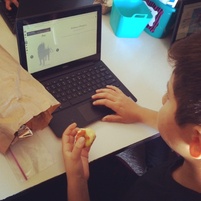|
A student cried in my classroom yesterday. This is not an entirely unusual experience, since we get teary eyed quite often while reading some of our favorite novels - like when Salva, a Lost Boy refugee in "A Long Walk to Water," goes back to war-torn South Sudan to build wells for his people. Or in "The Tiger Rising" when Rob, a troubled boy whose mother died, finally opens up to his father and lets all of his emotions pour out. Oh, and lots of kids also got a little misty while reading "Rules," wherein a boy with cerebral palsy makes his first-ever friend. So, crying is sometimes just part of the larger context of our classroom, and I've been known to shed tears, too. No matter how many years I've read some of these books with my classes, it always feels special to connect not only with literature, but with one another, too. Yesterday was different. 
This time, one of my students stayed after school to work on a digital storytelling project that she is undertaking. One of my language arts students and also an after school AV Club devotee, I've been encouraging this wonderful young lady all year. Ever since she proudly told me that she is a folklorico dancer on the evenings and weekends, I've enthusiastically urged her to share her story. I know that as teachers we're not supposed to earmark favorites, because they are all our kids, but I am so touched by this girl and her family. With immigrant parents and a house on the other side of the freeway, her family makes time to drive her to school every morning. Super studious, constantly in motion, and quite a chatterbox, she always has stories to share - like the morning after President Obama's executive order regarding immigration. She came right up to me, smiled brightly, and proclaimed, "Did you hear? The president forgives us and says we can stay. My mom cried last night, because she is so happy."
This student has worked for a week on writing a script about folklorico. As her guide, my job at this phase of the production process is to offer suggestions on storytelling. I began with the positive aspects of her topic, complimented her storyboard ideas, and affirmed that I thought she had a wonderful story to share. Then, I tried to explain the difference between "showing" and "telling" when writing a script. She nodded vigorously, but still seemed confused. So, I referenced an entry from Julie Barda's class in last year's DigiCom Film Festival and pulled it up to use as an anchor video: Our Story from DIGICOM Productions on Vimeo. I think we only watched about 45 seconds before she started crying. I immediately paused the video, worried. Worried that I had somehow offended her, worried that she was discouraged, worried that I wasn't being gentle enough in my critique. For the first time ever, I didn't know what to do or say when confronted with tears. I decided to wait her out, offer Kleenex, and listen. It was a good strategy. "This is a good story," she told me. "It makes me think of my mom and my experience in kindergarten. It makes me think of my culture and how proud I am of what my family has done." "Good," I responded. "You should absolutely feel proud to be who you are." "And, I get it now," she said. "I understand what you mean about my script. But I don't know how to fix it." After a few beats, I asked her why she dances. I asked her to think about what she feels when she dances and what keeps her showing up at practice every week. I asked her why the long hours, the elaborate costumes, and the music are so appealing when other kids her age tend to focus more on Instagram and Snapchat. More tears welled up in her eyes as she considered her answer. "Because. I forget everything else in my life, all my trouble and all my worry. I don't think about anything but the music and the steps and I feel joy." And that perfect revelation was the heart of her story. Sometimes, as a script writer, there are quiet moments when everything comes together and the story works out just right. The key to digital storytelling is to write from the heart, and some of the most compelling stories that can be told are the ones about ourselves. This morning, I arrived at work a few minutes later than usual. On my desk, in a zip lock bag, there was an SD card with a sticky note:
2 Comments
There are a million reasons why I think gamification is an important tool for teachers to implement. I've read plenty of articles, set up a Tweet Deck column for #gamification, attended a phenomenal Minecraft session at #CUE14, and participated in a #caedchat to learn more. But, at the end of the day, there are a million reasons why I never really got the gamification ball rolling. Here are a few:
So, with all of these questions and a complete lack of experience, I felt stuck in a kind of ideological purgatory where my professional goal of gamification didn't really seem all that attainable. For a while, it was just easier to put this on the back burner and get on with app smashing, digital storytelling, and 20% projects. Then, I had the chance to learn about Class Craft from Ricardo Higuera at EdCampPS - and I finally found my entry point into classroom gamification. Mages, Warriors, and Healers: Oh, My!
My husband grew up playing D&D and all kinds of other role playing games, but I grew up in farm country and we just sort of...went outside. So, coming from the standpoint of having zero experience with role playing games, I was amazed to find that Class Craft is easy to understand. It also has a user-friendly interface, and is versatile enough that it can be implemented in any classroom.
Essentially, students operate both individually and in teams. They take on the roles of three different character classes: mages, warriors, and healers. Each team decides how to balance the roles within their group and generates their own "recipe" for success. Students earn "powers" specific to their character class, and throughout the day the teacher acts as the Game Master. The Game Master has a lot more than just a rockin' job title - they award points and control different aspects of the game. For example, students work to earn XP (experience points) which help level up their characters. Leveling up is good because it unlocks more powers. The Game Master can also dock HP (health points) for negative behaviors and players use up AP (action points) as they utilize their powers throughout the period. The thing I love most about Class Craft is that everything is 100% customizable. Here's a quick screencast to show you how I have customized the game for my students: The Net Effect (Or, Why Class Craft is EduAwesome)
I implemented Class Craft immediately after EdCampPS because I just couldn't wait! The first day, I used this Google Presentation to explain game protocols:
There was an immediate, observable difference in student motivation. Classroom management has never been a significant issue for my classes, because I've always used a token economy that worked well to control behavior. However, there are usually a few students for whom it can be difficult to find the right carrot - not to mention that I tend to focus much more on intrinsic motivation as opposed to extrinsic.
Gamification matters because it motivates. By introducing Class Craft, there was a new layer of energy in the room, a new excitement for completing daily tasks and working together. Now, I fully understand that in order to be completely valid, strategies need to stand the test of time. But, so far, it's so good! Students who haven't attended tutoring in a month or so were in my classroom every day after school this week. More than half of each class spent at least 2 or more days in lunch tutoring, too. Group leaders are taking their role very seriously, helping to monitor and motivate students who struggle to stay focused. Best of all, there is a hum of excitement and anticipation as we gear up for the Daily Event, spin the Wheel of Destiny, and dread the Book of Laments.
Class Craft is everything I wanted gamification to look like in my classroom, and the benefits of gamification are everything I wanted them to be. I'm looking forward to reporting back after a few weeks. Hopefully, I'll have even more positive things to say and an even bigger impact to share.
|
Author: Jessica PackCalifornia Teacher of the Year. CUE Outstanding Educator 2015. DIGICOM Learning Teacher Consultant. 6th Grade Teacher. Passionate about gamification, Minecraft, digital story-telling, and fostering student voices. Download:Archives
June 2020
Categories
All
|







 RSS Feed
RSS Feed